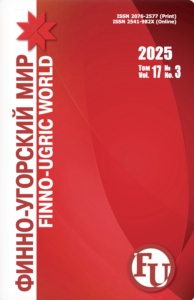Kornishina Galina A.,
Doctor of History, Professor, Department of History of Russia,
Ogarev Mordovia State University (Saransk, Russia), kornihina@rambler.ru
Introduction. On the basis of literature sources and field materials, the article gives the analysis the age specificity of the norms of collective communication inherent in the Mordovian rural population of Samara region and the corresponding terminology. The choice of this study is defined by the specific features of traditional ethical norms, which it is advisable to consider in an organic connection with a certain age and gender stratum (group) of the rural community. The age specificity introduces corrections into the system of ethical views and norms of behavior of ethnic and social communities.
Materials and Methods. The relevance of the study of this topic is defined by the realization of the enormous humanistic potential inherent in traditional norms of communication, which can become the foundation for moral and spiritual education of modern youth. The considered problem should be solved at the regional level, as the culture of Mordovian communication has a specific feature for its separate ethnoterritorial groups. This is especially true for multinational regions, like Samara region.
Results and Discussion. The research conducted within the framework of the article showed that the communication of representatives of different age and sex groups of rural society occurred both on weekdays and during leisure hours. It manifested itself in various forms, and their ethical norms were defined by the person’s belonging to a certain sexual, age, social group, which determined the status, social and religious functions, as well as behavior in the process of communication.
Conclusion. The analysis of field material allows to draw a conclusion about the unity of traditional forms of communication and the norms of collective and individual behavior of the Mordovians of Samara Region and other regions corresponding to them. Differences are revealed only in the form of variants of different forms of communication and behavior. The reasons for their emergence were the contacts of the Mordva with various ethnic groups, as well as the changes in socio-economic conditions of life.
Key words: sex-age groups; the socio-age status; suprydki; suspenders; Round dance (corovod, caragod); gatherings; ashtema; teiteren’ piya (“maiden beer”); Kudo beer (“beer house”); Rounds of yards; “Conversations”.
For citation: Kornishina GA. Social’no-obrjadovaja rol’ i formy organizacii polovozrastnyh kontaktov mordovskogo naselenija Samarskogo kraja v pervoj polovine XX v. [Social and ritual role and forms of organization of sex-age contacts of the Mordovian population of the Samara Region in the first half of the 20th century]. Finno-ugorskiy mir = Finno-Ugric World. 2017; 1: 78–85. (In Russ.)
- Belyaeva NF, Tyugankova EV. Sotsiokul’turnaya adaptatsiya samarskoy mordvy v usloviyakh polikul’turnoy sredy [Socio-cultural adaptation of the Samara Mordovians in a multicultural environment]. Saransk: Mordov. gos. ped. in-t; 2016. (In Russ.)
- Boyarkin NI, Boyarkina LB. Muzykal’noye iskusstvo [Musical art]. Mordva: ocherki po istorii, etnografii i kul’ture mordovskogo naroda= Mordva: essays on the history, ethnography and culture of the Mordvinian people. Saransk; 2012: 494–525. (In Russ.)
- Kornishina GA. Traditsionno-obryadovaya kul’tura v sisteme mordovskogo etnosa (struktura, sub”yekty, sostav, komponenty): dis. kand. ist. nauk [Traditional ritual culture in the system of Mordovian ethnos (structure, subjects, composition, components): Ph. D. historical. sci. dis.]. Saransk; 2001. (In Russ.)
- Kornishina GA. Traditsionnyye formy kollektivnogo obshcheniya mordvy Samarskogo kraya [Traditional forms of collective communication of the Mordva of the Samara Region]. Etnos i kul’tura = Ethnos and Culture; 1997; 1: 5–9. (In Russ.)
- PMA, 1996. Koshkinskiy r-n Samarskoy oblasti, d. Gorodok (informant Zhegunova A. S., 1904 g. r.) [Koshkinsky district of the Samara region, Gorodok village (informant Zhegunova AS, born in 1904)]. (In Russ.)
- PMA, 1996. Koshkinskiy r-n Samarskoy oblasti, d. Gorodok (informant Mochalova N. K., 1913 g. r.) [Koshkinsky district of the Samara region, Gorodok village (informant Mochalova NK, born in 1913)]. (In Russ.)
- PMA, 1996. Koshkinskiy r-n Samarskoy oblasti, s. Grachevka (informant Adayeva A. I., 1907 g. r.) [Koshkinsky district of the Samara region, p. Grachevka (informant Adaeva AI, born in 1907)]. (In Russ.)
- PMA, 1996. Krasnoyarskiy r-n Samarskoy oblasti, s. Staraya Binaradka (informant Borisova O. P., 1927 g. r.) [Krasnoyarsk district of the Samara region, 1996, Old Binaradka village (informant Borisova OP, born in 1927)]. (In Russ.)
- Fedorov N. Zametki o mordve sela Shentaly [Notes on the Mordva of the village of Shentaly]. Samarskiye gubernskiye vedomosti = Samara provincial lists; 1863; 48: 321–323. (In Russ.)
- Chuvashev MI. Teyteren’ piyan’ kudo – Devichiy dom piva u erzian [Teiteren piyan kudo Maid’s house of beer]. Dukhovnoye naslediye narodov Povolzh’ya: zhivyye istoki = Spiritual heritage of peoples of the Volga region: living sources. Samara; 2001: 13–29. (In Mordovian)






















